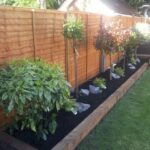Are you looking to enhance your cooking with the freshest, most flavorful herbs? Designing an herb garden layout is the perfect way to cultivate these essential ingredients right in your own backyard. The key to a successful herb garden lies in thoughtful planning and design. Whether you are a seasoned gardener or just starting out, understanding the basics of creating an efficient and appealing herb garden layout is essential.
Selecting the right location for your herb garden is crucial for its success. Factors such as sunlight, soil quality, and accessibility all play a role in determining the optimal spot for your green haven. The next step is choosing the best herbs for your garden – considering both culinary and medicinal uses can help you prioritize which herbs to include in your layout.
Companion planting is an important aspect of herb gardening that cannot be overlooked. By understanding which plants benefit each other when grown together, you can create a harmonious and thriving ecosystem within your herb garden.
In this article, we will explore the various elements involved in designing an efficient and visually appealing herb garden layout, as well as tips for maintenance, harvesting, and utilizing your homegrown herbs. So let’s embark on this exciting journey of discovering the benefits of designing an herb garden layout.
Selecting the Right Location for Your Herb Garden
Choosing the right location for your herb garden is crucial for its success. Most herbs require at least 6 hours of sunlight, so it’s important to choose a spot that receives an adequate amount of sunshine. Take note of any structures or trees that may block sunlight throughout the day and plan accordingly.
In addition to sunlight, proper drainage is essential for herb gardens. Herbs do not thrive in waterlogged soil, so it’s important to avoid areas where water tends to accumulate. If your chosen location has poor drainage, raised beds can be a great solution to ensure that your herbs have the proper growing conditions.
Another factor to consider when selecting a location for your herb garden is proximity to your kitchen. Placing the garden near your cooking area makes it convenient to harvest fresh herbs while preparing meals. This also serves as a reminder to regularly tend to and care for your herbs.
Moreover, keep in mind that some herbs are more sensitive to extreme temperatures than others. For example, tender herbs like basil and cilantro prefer warmer temperatures, while hardy herbs like rosemary and thyme can withstand colder conditions. Understanding the specific climate needs of each type of herb will help you choose the best location for your garden.
| Location Factors | Considerations |
|---|---|
| Sunlight | At least 6 hours of sunlight per day |
| Drainage | Avoid waterlogged soil; consider using raised beds if necessary |
| Proximity to Kitchen | Convenient access for harvesting and maintenance |
| Climate Needs | Select suitable location based on temperature requirements of specific herbs |
Choosing the Best Herbs for Your Garden
When it comes to choosing the best herbs for your garden, there are a few factors to consider. One important factor is considering the climate and growing conditions in your region. Some herbs thrive in hot, dry climates, while others prefer cooler, moister conditions. It’s important to research which herbs are well-suited for your specific area before making your selections.
Another important consideration when choosing herbs for your garden is how you plan to use them. If you’re an avid cook, you may want to focus on culinary herbs such as basil, thyme, and rosemary. On the other hand, if you’re interested in creating herbal remedies or teas, you may want to include medicinal herbs like chamomile, lavender, and echinacea in your garden.
It’s also a good idea to consider the growth habits of the herbs you’re interested in planting. Some herbs are more invasive and may spread rapidly if not kept in check, while others are more compact and well-behaved.
Understanding the growth habits of different herbs can help you plan and design your herb garden layout more effectively. By taking these factors into consideration, you can choose the best herbs for your garden that will thrive in your specific growing conditions and meet your needs and interests.
Understanding the Importance of Companion Planting in Herb Gardens
Companion planting in herb gardens involves planting different herbs and plants together to maximize growth, deter pests, and enhance flavor. This traditional gardening practice has numerous benefits and can contribute to the overall success of your herb garden. Here are some reasons why companion planting is important in herb gardens:
- Beneficial insect attraction: Certain herbs, when planted together, can attract beneficial insects that help control pest populations naturally. For example, planting dill alongside cilantro can attract predatory wasps that feed on harmful pests like aphids.
- Soil improvement: Companion planting can improve soil health by enhancing nutrient uptake and preventing soil erosion. Herbs such as mint and chamomile release essential oils that act as natural fertilizers and improve the overall soil structure.
- Weed suppression: Selecting the right companion plants can help suppress weed growth in your herb garden. For instance, planting basil near tomato plants can inhibit weed growth while also enhancing the flavor of the tomatoes.
By understanding the importance of companion planting in herb gardens, you can create a more sustainable and thriving gardening environment. Consider researching which herbs complement each other best and experiment with different combinations to see what works best for your specific garden layout and goals.
Designing and Planning the Layout of Your Herb Garden
When it comes to designing and planning the layout of your herb garden, there are several factors to consider in order to create a functional and aesthetically pleasing space. The layout of your herb garden will not only impact the visual appeal of your outdoor space but also affect the growth and overall health of your plants.
Consider Sunlight and Shade
One of the most important aspects to consider when planning the layout of your herb garden is sunlight and shade. Most herbs require full sunlight for at least 6 hours a day, so it’s essential to choose a location that receives adequate sunlight. However, some herbs thrive in partial shade, so consider planting these in areas that receive less direct sunlight.
Utilize Vertical Space
If you have limited space for your herb garden, consider utilizing vertical space by incorporating trellises, hanging planters, or wall-mounted herb gardens. This not only maximizes space but also adds visual interest to your garden.
Group Herbs Strategically
When designing the layout of your herb garden, it’s important to strategically group herbs based on their watering needs, growth habits, and compatibility with other plants. Grouping herbs with similar requirements together can make it easier to care for them and promote healthier growth. Additionally, consider incorporating companion planting principles by placing herbs that benefit each other when planted together.
By carefully considering factors such as sunlight, shade, vertical space utilization, and strategic grouping of herbs, you can create a well-designed herb garden layout that not only looks beautiful but also supports the health and productivity of your plants.
Tips for Creating a Functional and Aesthetic Herb Garden Layout
Creating a well-designed and visually appealing herb garden layout requires careful planning and consideration. Not only should your herb garden be functional, providing easy access to your herbs for maintenance and harvesting, but it should also be aesthetically pleasing to enhance the overall look of your outdoor space. Here are some tips for creating a functional and aesthetic herb garden layout:
Integrate Paths and Walkways
When designing the layout of your herb garden, consider integrating paths or walkways to provide easy access to all the herbs. This not only makes it convenient to tend to your plants but also adds a structured and organized look to the garden. Paths can be made with materials such as gravel, stepping stones, or brick pavers, depending on the overall style of your outdoor space.
Use Raised Beds or Containers
To create visual interest and improve accessibility in your herb garden, consider using raised beds or containers. Raised beds can help define different sections of the garden while providing good drainage for your herbs. Containers can also add versatility, allowing you to move herbs around as needed and creating varying levels within the garden for added dimension.
Incorporate Vertical Elements
Incorporating vertical elements such as trellises, arbors, or wall-mounted planters can maximize space in your herb garden while adding a decorative touch. Vertical gardening not only creates more planting opportunities but also adds height and interest to the overall layout. Consider growing climbing herbs like rosemary or thyme on a trellis to free up ground space for other plants.
By considering these tips and incorporating them into the design of your herb garden layout, you can create a beautiful yet functional outdoor space that provides an abundance of fresh herbs for culinary use and aesthetic enjoyment.
Maintaining and Caring for Your Herb Garden
Once you have designed and planted your herb garden, it is essential to maintain and care for it to ensure that your herbs thrive. Here are some tips for maintaining and caring for your herb garden:
1. Watering: Different herbs have different water requirements, so it is crucial to understand the specific needs of each herb in your garden. Some may need more water, while others may prefer drier soil. Be sure to water your herbs accordingly to prevent them from drying out or becoming waterlogged.
2. Pruning and Harvesting: Regular pruning and harvesting are essential for the health of your herb garden. This not only encourages new growth but also prevents the plants from becoming overcrowded. It is important to prune your herbs regularly to remove any dead or damaged foliage.
3. Pest Control: Keep an eye out for any signs of pests or diseases in your herb garden and take action as soon as you notice any issues. There are various natural methods for pest control, such as using companion planting with pest-repelling herbs or creating homemade organic sprays.
By following these maintenance tips, you can ensure that your herb garden remains healthy and productive, providing you with a constant supply of fresh herbs for culinary use or home remedies. Remember that caring for your herb garden is an ongoing process that requires dedication and attention to detail, but the rewards of having a flourishing herb garden make it all worthwhile.
Harvesting and Using Your Homegrown Herbs in Cooking and Remedies
In conclusion, harvesting and using your homegrown herbs in cooking and remedies is the rewarding culmination of all your hard work in designing and maintaining your herb garden. After carefully selecting the perfect location, choosing the best herbs for your garden, understanding companion planting, and planning the layout, you are now able to reap the benefits of your efforts.
By harvesting your homegrown herbs, you will have access to a fresh and flavorful supply of ingredients for cooking. Imagine adding a handful of freshly picked basil to a homemade tomato sauce or garnishing a dish with fragrant sprigs of rosemary. Not only will using your own herbs enhance the taste and aroma of your culinary creations, but it will also provide a sense of satisfaction knowing that you have nurtured these plants from seedling to table.
Furthermore, utilizing your homegrown herbs in remedies can offer natural solutions for common ailments. From soothing teas made with mint or chamomile to healing salves containing lavender or calendula, having access to medicinal herbs from your own garden can be both convenient and beneficial for promoting wellness in yourself and others.
The process of cultivating, harvesting, and using these plants fosters a deeper connection to nature and an appreciation for the versatility of herbs beyond just culinary use. So go ahead – put those freshly harvested herbs to good use in nourishing meals and healing concoctions.
Frequently Asked Questions
What Is the Best Layout for an Herb Garden?
The best layout for an herb garden depends on the space and available sunlight. Generally, it’s best to place taller herbs like rosemary or basil in the back and smaller ones like thyme or oregano in the front. Consider planting perennial herbs in separate compartments to make it easier to manage their growth.
How Do You Arrange Herbs in a Herb Garden?
Arranging herbs in a garden should take into account their water and sunlight needs. Some herbs prefer full sun, while others thrive in partial shade. Grouping herbs with similar needs together will help them grow better and make it easier for you to care for them.
What Herbs Grow Best Together?
Certain herbs grow well when planted together due to their similar watering, lighting, and soil needs. For example, basil is great when planted next to tomatoes because they both require lots of sunlight and moist soil. On the other hand, mint grows well with chives because they have compatible growing conditions and won’t compete with each other too much.

Welcome to my gardening blog! I am passionate about plants and enjoy sharing my knowledge and experiences with others. In this blog, I will write about everything related to gardening, from tips on how to get started to updates on my own garden projects.





